 |
||
|
||
| ||
A detailed theoretical review of the nForce's specifications can be found in our nForce chipset preview. Today we are going to test operation of a south bridge on products based on this chipset. Well, we are mostly interested in an MCP modification (Media and Communications Processor) called MCP-D which supports hardware real-time encoding into Dolby Digital. 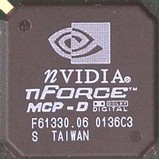 To check the specified characteristics and to test quality of realization of different sound functions we used a reference mainboard from NVIDIA and a sample of a production mainboard ASUS A7N266. Test system:
 First of all, a brief reference book:
An ACR slot has the same functions as an AMR one. The latter can be found mainly on mainboards designed for AMD processors (on VIA and ALi chipsets). The AMR slot (of 46 pins) transfers signals for an AC97 codec and a USB bus. An AMR card of the ultimate configuration realizes a sound card, a modem and, probably, a USB hub. An ACR is an extension of the AMR (and AMR boards can work also in the new slot). Now in a 120-pin connector AMR signals are supplemented with one MII interface (Media Independent Interface), one additional interface (it can be MII or GPSI) and an IPB interface (Integrated Packet Bus). Besides, it is planned to add an interface for a wireless network controller as further development of the standard. The following variants are suggested as base configurations:
(since the specifications are under development this table can be changed) Besides, the cards can implement functions of AC97 sound (with support of 6-channel codecs) and additional USB ports. The ACR.Basic class includes cards which use only possibilities of the AMR (i.e. sound, modem and USB). By the way, one of the advantages of such highly integrated solution is usage of one external connector for implementation of several functions. For example, you can simultaneously connect modem+HPNA+DSL to the RJ11. The ACR is an open standard, and today there are more than 50 companies that joined ACR SIG , for example, 3Com, AMD, NVIDIA, VIA etc. Although there are quite few devices for an ACR bus, I think they will be much more in future. Just for comparison let me demonstrate possibilities of another alternative standard - Intel's CNR:
All these standards allow transmitting some functions of ACR/CNR expansion cards onto a mainboard. So, any mainboard with an ACR slot (and the chipset's support) can use a network controller in this slot. But since the NVIDIA's product is the first ACR card in our lab we will examine it together with the nForce's south bridge. Unfortunately, at present drivers for the HPNA and modem are not available that is why communication functions will be studied only by the example of the 10/100BaseTX network controller. Capabilities of all desktop network adapters are very similar. Today we are primarily interested in a data rate and CPU utilization. The basic part of the adapter is integrated into the MCP, and the expansion card incorporates only ICS1893 - a physical level controller chip from Integrated Circuit Systems, Inc., and a matching transformer. The RJ45 connector for a twisted-pair cable has two indication LEDs - speed/link and activity. The adapter has several parameters which can be adjusted in the registry:
As contestants we used adapters based on the Realtek 8139 chip which is often used in inexpensive 100Mbit network controllers. During the tests we recorded a large file (1 GBytes) and measured time and an average CPU utilization. The test was carried out under the Windows 2000 with a TCP/IP protocol.   As you can see, a network controller of the nForce chipset is quite competitive in its class. In the CPU utilization and in the speed with the auto settings it falls just a bit behind a usual network adapter. But not all manufacturers choose such realization of a network controller on the nForce mainboard. ASUSTeK installed an external normal network chip from Realtek, and MSI used an integrated one. Other companies also use realizations of network controllers based on chipsets quite seldom. They can be found probably only on highly integrated boards with SiS and Via chipsets. It is only Intel who uses a network controller in the 82801BA ICH2. Audio Processing Unit (APU)Let's remember the main features and advantages of the APU:
 As for sound features the ACR card supplied with the reference mainboard has only a 4-channel Sigmatel STAC9708T codec and connectors. The whole processing digital part is located in the MCP in its APU. You should understand that thanks to the ACR it is possible to connect devices directly to a chipset which incorporates a special DSP for management, processing and output of sound streams. Therefore, we can avoid bottlenecks of a traditional architecture where a sound card shares a PCI bus with other devices which can badly affect sound. All these issues are usually avoided in testing of performance of motherboards when sound is just turned off. But users often play 3D games with sound. And it is often multichannel 3D sound which takes much computational resources. For example, if you use sound cards with an HSP (with program processing of audio data at the expense of a CPU) or those which have 3D sound API on a program level it can decrease FPS, get sound disappear or cycle or cause crack. The nForce lacks for such drawbacks. Let's come back to the ACR slot. This connector makes a configuration more flexible and expandable. As a computer requires at least minimal sound possibilities, the NVIDIA's reference board has at default AC'97 stereo codec Sigmatel STAC9721T and 3 standard connectors: linear-out, linear-in and mic-in. So, an ACR card adds wanting outputs to rear, central speakers and a subwoofer and a digital optical output. The latter can be used for minidisc devices from SONY, an external higher-quality DAC or a Dolby Digital decoder. In case of the ASUS mainboard the manufacturer solves the problem differently: for cheap versions with an economical chipset it equips the board CMI8738 sound chip (which despite all its advantages has a high level of distortions), for more expensive solutions the board is supplied with an ACR card with two AC'97 codecs onboard, all required analog outputs and a digital electric S/PDIF connector (RCA).  In course of testing of the nForce we had some general questions. And some explanations were kindly given by Luciano Alibrandi from the NVIDIA's European Department.
Drivers for the nForceAt present the nForce has drivers for Windows ME, Windows 2000 and Windows XP. Each of them comes with a separate self-installing distributive. We waited for the latest drivers of v5.10.2813 of 19.12.2001 where all drawbacks should be eliminated. Windows 98SENone of the current drivers (5.10.2722, 5.10.2724, 5.10.2803, 5.10.2813) for Windows ME can be automatically installed onto Windows 98SE. The message says: "Setup detected that the operating system in use is not Windows ME. The installation will be terminated." We tried to install the drivers manually through INF files, but not all devices can be detected this way. Sometimes the system slows down. The conclusion is that owners of the Windows 98SE should think of the Windows ME, especially considering that Microsoft stops supporting the W98 and applications developed for it. Nevertheless, if should know that the drivers for sound in W98SE, as well as in ME, work and support EAX 1.0, EAX 2.0, I3DL2 (the I3DL2 is an open standard of sound positioning similar in functions to the EAX 2.0, developed by IA-SIG and included into the DirectX 8).  The fact that this is not a Sensaura driver doesn't mean that Sensaura algorithms are not used. This utility just failed to find dlls which provide support for 3D sound for sound cards based on the Sensaura technologies. For the nForce the structure of the drivers differs from a usual one, that is possibly why the utility says it. In fact, this utility is good only for one thing: it quickly and clearly shows compatibility with EAX 1/2 and I3DL2. It is very important when you are dealing with 2 mainboards, 4 operating systems and 4 driver versions :) Windows MEAll driver versions support this operating system. The latest version (5.10.2813) lacks for a utility for audio management called NV Audio Panel. But you can take it in another version. Appearance and functions of the control panel do not change much in each new version. The first tab contains links to standard Windows utilities. 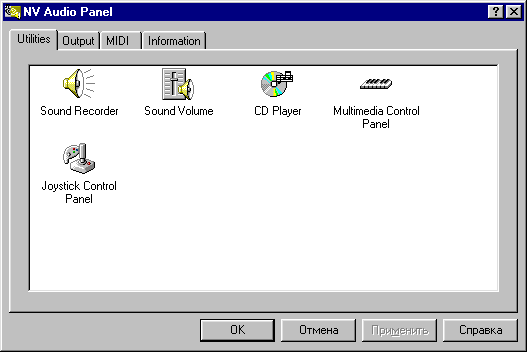 The second tab is the most important one. It includes management of modes of digital and audio outputs. For an analog-out the Dolby-Surround allows coding multichannel sound for further creation of 3D sound on a Dolby Pro Logic analog decoder. A digital-out can work in stereo, Dolby Pro Logic and Dolby Digital modes. The latter means both encoding of channels into Dolby Digital and a pass-thru mode for redirection of an AC3 or DTS stream to an external decoder. Since a format of the signal doesn't change (S/PDIF) it doesn't matter how all this works as a hardware decoder recognizes it according to service data in the signal.  Some versions may have this tab looking differently:  The next page is designed for MIDI. Here you can set DLS or SF2 bank for a MIDI synthesizer. I tried to set a 32 MB GM/GS bank Reality, meant for a SoundBlaster Live! sound card and had no problems with MIDI reproduction. A level of MIDI effects can be set below. 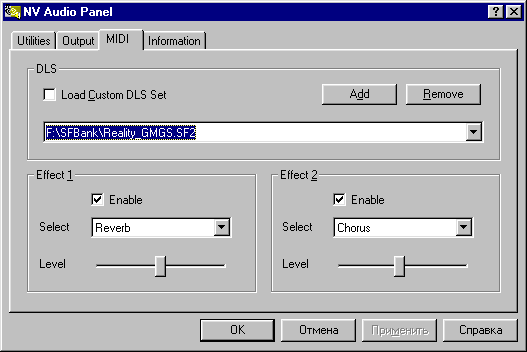 Information tab is not very useful:  After the drivers are installed the system gets the following sound devices:  Like the 98SE, the Windows ME supports EAX 1.0, EAX 2.0, and I3DL2. Positioning and reverberation in every 3D sound API can be tested by the Player3D program.  In this program you can choose a mode of speakers, reverberation API, environment presets and then start a sound source along some trajectory. We have found out that the nForce has excellent positioning of sound sources and high-quality reverb. Positioning along a vertical axis is also well heard. Unfortunately, support of Sensaura extensions - MacroFX and ZoomFX is lacking. Or maybe this program fails to detect them. However, I don't know any other programs which would detect a presence of these technologies. Let's talk about digital output. As the nForce was developed for the X-Box from Microsoft it had an effect on its increased functionality. When home theaters became quite popular many users bought a 5.1 acoustic system and an AV-receiver (decoder and a 5-channel amplifier in one). As a rule, it has several digital-ins and analog stereo-ins instead of multichannel analog inputs. It is impossible to transfer multichannel information within a standard S/PDIF protocol because of bitrate is limited up to PCM stereo only. And to get normal multichannel sound in games it is necessary to encode a signal on the fly into some format with compression, for example, Dolby Digital 5.1. Well, with the nForce in use sound was really encoded into Dolby Digital 5.1 and then recognized and decoded by an external hardware decoder! We tried a decoder from the DTT3500 set and a home AV-receiver Onkyo TX-DS484. I think this function will be vital for owners of hardware DPL/DD decoders provided only with stereo sound in games. Furthermore, the rumor has it that there can be a delay caused by encoding and then decoding of a signal. As for me, I didn't notice any delay in case of the integrated hardware encoder when the signal passed to the decoder. Probably, hardware acceleration of sound and direct resource management in the APU allows eliminating any delays. Besides, the fact that the chipset is designed for a game console helps to avoid such problems. By the way, usual PCI sound cards have a certain delay time. Those users who have no hardware decoders will use 6 analog-outs of the ACR cards to connect an active 5.1 acoustic system. But there are no presets and settings for analog-outs in all current drivers and in the registry, though at www.anandtech.com we have found a tab with such settings: 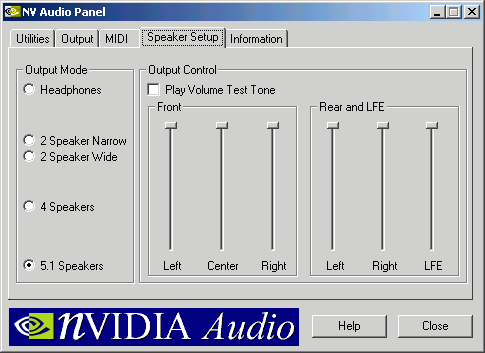 Maybe we will see these settings in new driver versions, but today two additional outputs to rear speakers and to center/sub do not work in any modes: in musical one, in games or in DVD movies. It relates to both tested mainboards and the expansion cards. Windows 2000The W2K SP2 is not an optimal choice for the nForce with current drivers. Everything works excellent, but EAX 1.0, EAX 2.0 and I3DL2 won't be supported in games. Upgrade the system up to Windows XP. Windows XPEverything works excellent with the drivers of v5.10.2813 under Windows XP with SP1 and DX8.1. 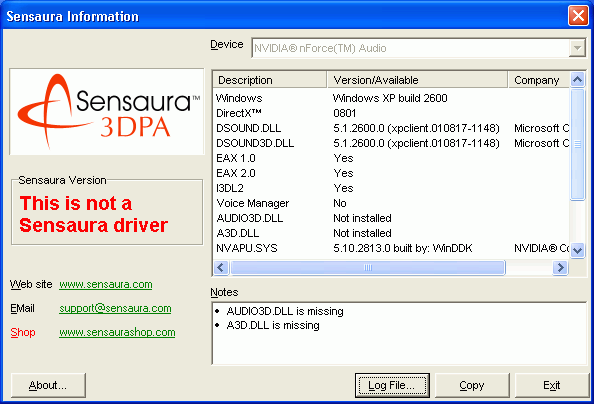 The WDM drivers do not have any problems in case of the nForce. The system works flawlessly, the sound is not broken, positioning and reverberation in games are OK. You should remember that NVIDIA lays emphasis exactly on the XP in development of drivers. To study capabilities of the nForce in the DirectSound under the XP we used a well known test program Minerva. Diagnostics of the Minerva 1.08: All specified characteristics in the number of accelerated streams on a hardware level do take place. In this aspect the nForce outscores Live! and Audigy sound cards from Creative and CS4630 based cards which have only 64 DirectSound and 32 DirectSound3D voices. Only the Philips Edge series has the same large number of voices supported on a hardware level. At present 32 voices are enough for games, but in future we may need more. That is why the nForce looks a more promising solution. Test of Linear-outThe test was carried out in the Windows XP by the RMAA 3.2 program (audio.rightmark.org is an official site of the project).
General performance: Very good (in
detail)
General performance: Good (in detail) If we know models of codecs a card is based on it is very easy to predict the results. And in this case they are as high as, for example, for Creative SoundBlaster Live! 5.1. This is very good quality for application of a signal to a multimedia acoustic system. Sound quality in games and musicWe listened to quality of sounding and positioning of sound sources in Max Payne, Serious Sam, Deus Ex and RTCW games. The nForce's sound subsystem demonstrates excellent sound reproduction at the level of modern multimedia sound cards on a PCI bus such as Hercules GT XP and TB Santa Cruz on the CS4630 or Live! and Audigy from Creative. And it is quite difficult to say which sounds better. Sound cards based on the Sensaura positioning algorithms, including the nForce, perform better in positioning on two speakers and in a vertical plane. But in our opinion the products from Creative have better reverb quality. In music (MP3, CD) there are no much differences on the cards even when the sound is produced by high-quality wooden speakers. Well, codecs (and, therefore, DACs) of all multimedia cards are identical today. The most of them are based on the SigmaTel STAC9708. The only vague issue connected with the nForce is sound in headphones. Since a buffering OA is lacking the codec's output stage gets overloaded when 32Ohm headphones are connected. Many sound cards lacks for such peculiarity as they have a quite powerful OA between the codec and the connector. AC'97 codecs from Analog Devices and C-Media CMI8738 audio chip also have internal adaptation to headphones. Should we expect sound cards from NVIDIA?Our colleagues from nvnews.net asked Brian Del Rizzo (NVIDIA PR Manager) about add-in sound cards from NVIDIA. Q: Does NVIDIA have any plans to enter the addin soundcard market? NVIDIA has several openings for Audio engineers on your website. A: As we've said before, no. The market for add-in audio cards has been steadily decreasing over the past couple of years, with the downward trend continuing even sharper moving forward. Q: Would it be safe to assume that follow-ons to nForce would have improved audio capabilities? A: Of course. We are fully committed to furthering development of integrated audio.. nForce Experience demo discTo demonstrate capabilities of the nForce NVIDIA prepared several demo programs and games. 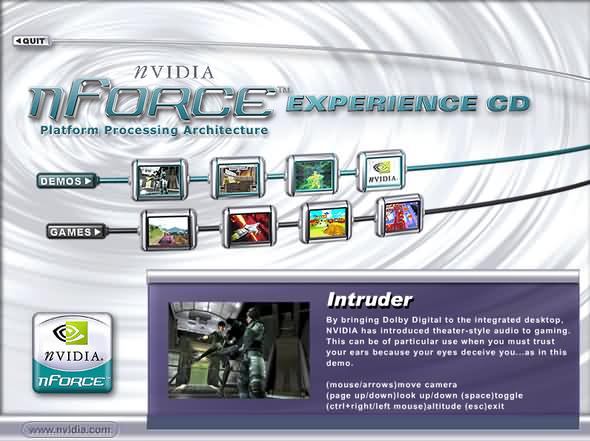 The most interesting demos are the first and the fourth ones which show the most advance capability of the nForce - coding into Dolby Digital. The first program called Intruder demonstrates some cinema-theatrical performance with a semitransparent girl and a submachine gunner. Sound is formed for all 5.1 channels, coded into 5.1 and output in a real time mode. Positioning and sharpness of the sound are really impressive even with the DTT3500! I expected quality losses caused by compression into Dolby Digital. But it's very pleasant that there is no difference between the mode with encoding and usual stereo on expensive multimedia speakers. The second program is a 5.1 channel AC3 stream recorded and reproduced without a video series. The quality of the sound and special effects is very high again. ConclusionThe audio part of the nForce has a great potential which can be revealed only if respective support in drivers and in games is provided. The current drivers for the ME and XP work excellently, as well as in games. The APU in the nForce is undoubtedly much more interesting than a usual stereo codec integrated in many mainboards. But to successfully compete against modern multimedia cards NVIDIA should attract users with multifunctional and convenient audio utilities (here they can follow an example of the Surround Mixer in the Creative Audigy or of the SoundMAX from Analog Devices). The only thing left ot do is to tweak the drivers. Currently there are problems with an absence "Speaker Setup" tab, the NV Audio Panel is lacking in the drivers for ME, a specified 7-band equalizer is also lacking and as we can see the Sensaura technologies - MacroFX and ZoomFX are not supported either. Highs of the APU nForce
Lows of the APU nForce
Write a comment below. No registration needed!
|
Platform · Video · Multimedia · Mobile · Other || About us & Privacy policy · Twitter · Facebook Copyright © Byrds Research & Publishing, Ltd., 1997–2011. All rights reserved. |